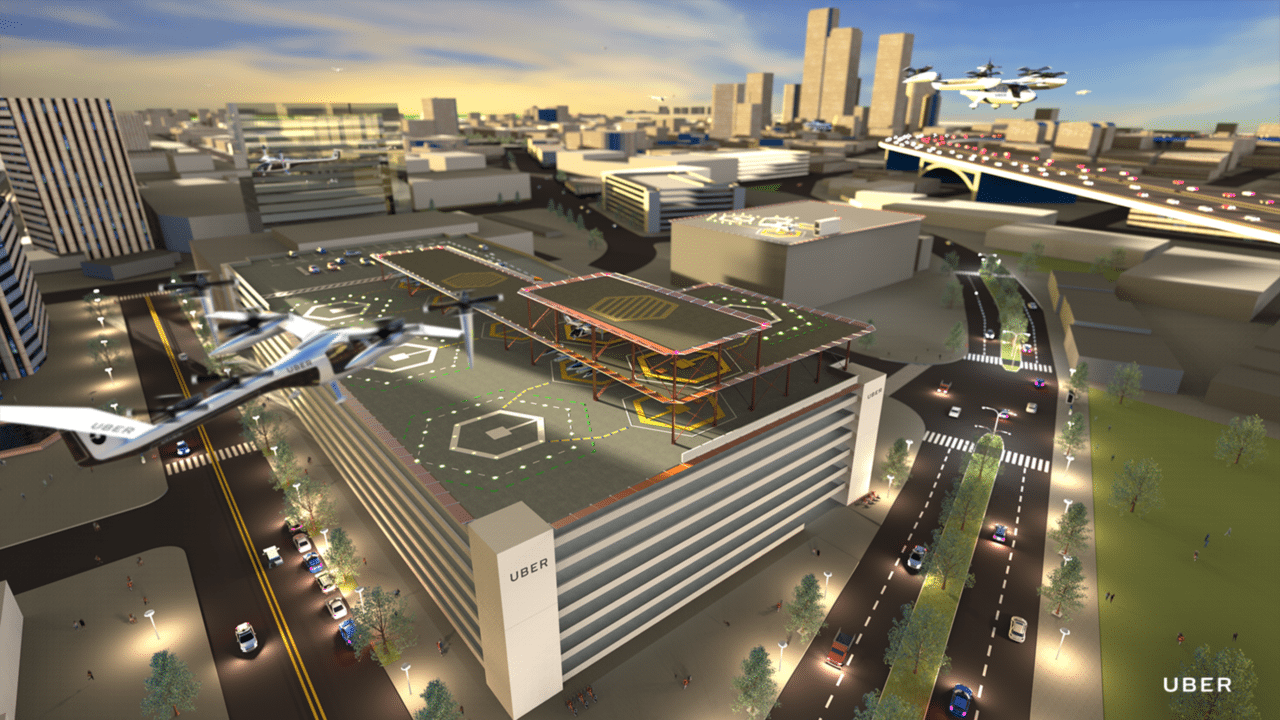
A rendering of an Uber vertiport. Image courtesy of Uber
A considerable decrease to the current FAA-controlled airspace separation requirements is a built-in assumption in Uber Elevate’s business model as the company scales up, according to Tom Prevot, Uber’s director of airspace systems.
Speaking at the Air Traffic Control Association’s annual conference in Maryland, Prevot said that companies would “design these vehicles to operate needing less airspace” and confirmed that, at scale, Uber projects takeoffs and landings from its vertiports every 24 seconds, which would require a considerable reduction in the current minimum-distance standards of 1,000 feet vertically or 3 to 5 nm horizontally, according to FAA order JO 7110.65.
David Rottblatt, business development director for Uber partner EmbraerX, elaborated on the expectation, expressing confidence in maintaining safety with a reduced minimum distance thanks to continually maturing CNS technology.
“That is, perhaps, one of the underlying assumptions of the EVTOL network would be allowed to scale,” he said. “One of the interesting challenges is, how can we better take advantage of our airspace? … A lot of constraints that exist in airspace today are not because controllers can’t do it or because the technology isn’t there. There’s a lot of procedures that create the constraints.”
Rottblatt said that if the technology can be demonstrated as safe, regulations should be changed to allow industry to scale up as much as the demand will support rather than restricting it for the sake of restrictions.
Confronted with the idea of the number of air taxis this business model would put in the skies at once, the panel moderator suggested that the companies would run into an ADS-B issue.
When pushed to elaborate, Prevot proposed Uber “using potentially something else” for identification, but did not provide specifics. ADS-B provides a challenge for the urban air mobility plan from the start because of the way air taxis will be used.
Uber, Prevot said, would prefer to find a solution that explores “what else [it] can do beyond call in traffic,” such as “create two-way communication” with air traffic controllers.
Rottblatt suggested that, at the start, the companies would use a 4G or 5G style of infrastructure for communications, but would need to monitor and study that solution for any latency that would become untenable as they scale up and look to remove pilots from the equation. Prevot, on the other hand, disagreed with that approach.
“I would argue we should do it when we start,” he said. “We’ve convinced ourselves it’s possible to start operating in the current paradigm. But if we want to create a scalable path, we should see where we can — within the current ruleset — create new paths.”
Neither companies’ representative was willing to commit to a technology, but they mentioned the possibility of 4G/5G communications proving themselves reliable as well as looking at very high frequency (VHF) and other solutions that they declined to name. One solution Prevot suggested would be pairing 4G/5G with a more-available/less-bandwidth option and using both.
Ongoing testing with drones will help provide more data to inform the companies about a future communications path.
The panel also tackled the issue of pilots. While the ultimate goal has always been autonomous vehicles, reliable and certifiable vehicles are still a way off.
“We don’t think we can go very quickly to autonomous,” Prevot said. “It’s very possible they will have to be commercial helicopter-rated initially. … That’s a very small amount of people that would then be available. So, we would like to get the vehicles to operate more simpler so we could also get into the pilot pool fixed-wing pilots, or set up training.”
While pilots will be a necessity, both Prevot and Rottblatt stressed that they still wanted to automate as much of the process as possible.
“I think the aircraft are going to be pretty automated and run from the fleet automation center,” Prevot said. If “the vehicles get disconnected, they have to find a safe landing spot. (We need to have) contingencies in mind.”
Prevot did note the importance of being careful as they try to develop this new industry and make it interoperable with the existing federal airspace.
“We can mess this up quickly if we don’t make safety and security paramount,” he said.